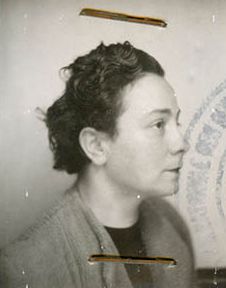Anna Sussmann
(Vienna 1909 – Vienna 1985): A woman in the Resistance
“You mustn’t say that you’re pregnant”
Born in Vienna in 1909, Anna Goldscheider lost her parents at an early age and was raised by her siblings in modest circumstances in the 9th District. Due to the family’s difficult financial situation, she was unable to pursue higher education, so she completed an apprenticeship as a milliner. Anna Goldscheider took acting lessons during her time as an apprentice and met the young stage designer Heinrich Sussmann, who went on to became her husband, at the Social Democrat Art Office. She had already made a number of contacts in the Social Democratic Workers’ Party at the Workers’ Gymnastics Club and had become a Party member. From 1929 she worked as a dentist’s assistant.
Following the February battles of 1934, the installation of the Austrofascist government under Engelbert Dollfuß and the prohibition of the Social Democratic Party, Anna Sussmann’s political activities also became illegal. She changed to the Communist Party (which was also banned) and became a Party member in spring 1934. In June 1937 she left Vienna, married Heinrich Sussmann, who was already living in Parisian exile, and continued her political work with him in the foreign branch of the Austrian Communist Party, mainly supporting Austrian fighters such as Hermann Langbein in Spain and after 1938 in the Cercle Culturel Autrichien, a cultural organisation for Austrians in exile. In 1939, her husband was arrested as an “enemy alien” and upon the outbreak of war he reported for military labour service. After the occupation of France by the German Wehrmacht, Anna and Heinrich Sussmann fled to Marseille and joined the resistance there. In 1942, despite danger, they returned to Paris via Lyon.
In 1944, the Sussmanns were betrayed and handed over to the Gestapo. At the end of July 1944, they were deported, via Drancy, to Auschwitz. While her husband was interned in the main camp, Anna Sussmann, who was heavily pregnant at the time, was sent to the women’s camp in Birkenau.
“Birkenau’s only function was as an extermination camp, we didn’t know that when we arrived. The women wanted news from us. We told them about the war developments (...). The women told us about the gas chambers. We didn’t really believe it. The next day (...) we saw the chimneys and experienced the smell. A Polish woman whispered to me: You mustn’t say that you’re pregnant.”
Her son was murdered by the camp doctor Josef Mengele the moment he was born. Anna Sussmann survived and was transferred to a subcamp of Groß-Rosen in October 1944. That winter, she and her friend Lilli Schlesinger managed to escape on their way to the labour camp. They made their way to Switzerland. After the war, Anna and Heinrich Sussmann, who had been liberated in Auschwitz, focused on tracking down Nazi perpetrators, but they were also active politically and as surviving eyewitnesses. In 1989, the Anni and Heinrich Sussmann Foundation was established, which supports artistic works dealing with democracy and Fascism.
Literature and sources
Radio Ö1, Im Journal zu Gast: Auschwitz-Überlebende Ehepaar Sussmann (09.02.1985), österreichische Mediathek, jm-850209_k02.
Interview with Anna Sussmann on 13 and 25 May 1982 (Interviewer: Hans Wittek); cassettes and transcript, Documentation Centre of Austrian Resistance (DÖW), DÖW interview 068.
Documentation Centre of Austrian Resistance: estate of Anna Sussmann.
Documentation Centre of Austrian Resistance, Erzählte Geschichte. Anna Sussmann: Ex-Autrichienne: https://www.doew.at/erinnern/biographien/erzaehlte-geschichte/exil/anna-sussmann-ex-autrichienne (16.12.2021).
Anna Sussmann, Deutschland ist schwarz. In: Karin Berger, Elisabeth Holzinger, Lotte Podgornig, Lisbeth N. Trallori, Ich geb Dir einen Mantel, dass Du ihn noch in Freiheit tragen kannst. Widerstehen im KZ. Österreichische Frauen erzählen, Vienna 1987, p. 247–252.

